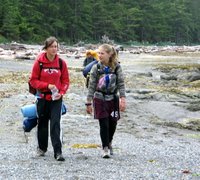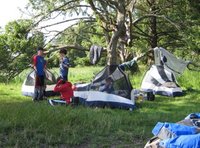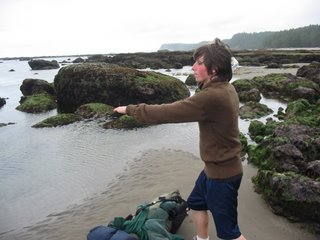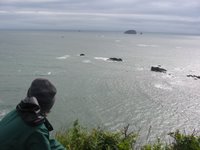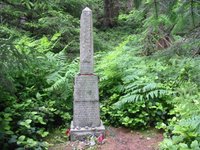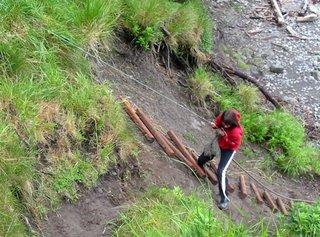
Seventh grade Adventure Education students woke at 7:00 AM. The entire group ate breakfast, brushed teeth, filled water bottles in a nearby stream, used the pit toilet, broke camp and cleaned up the area. In the midst of these efforts, students spotted a deer sampling some of the nearby salmonberry leaves. Also, a raccoon was spotted walking around on the beach searching for food.
Students began hiking toward Cedar Creek at 10:00 AM. A dead, putrid sea lion was encountered while rounding Johnson Point. The smell of the beast resulted in a quick retreat from the carcass. Hiking around Johnson Point was slow going because of its rocky nature.
The group finally broke onto a sandy beach just north of Johnson Point. The hikers stopped at a large waterfall and filled empty bottles. Several students attempted to dam the stream while others climbed up the banks of the falls. The group continued on after approximately twenty minutes.
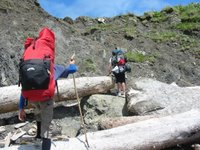
Further north, the students encountered their first overland route. This marked route allowed for safe travel over the headland when the tide was too high to hike around it. Each group member scrambled to the top and slowly inched their way down the other side. A flat, sandy beach existed beyond the overland route.
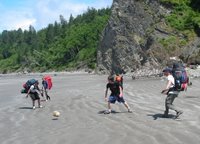
Mr. Scoles found a large cork and started a short soccer/keep away game on the beach. Several students joined in.
After several more miles, the Adventure Education group reached Cedar Creek. To the group’s surprise, no one was camping in the area. Students quickly set up their tents and hung wet clothes on branches to dry. Several students gathered firewood and started a fire. After this work was done, students took a dip in Cedar Creek.

Later in the evening, a rope swing, located on the hill above the campsite, was used extensively.
Students discovered a dead pelican while exploring the beach north of camp. This find triggered a shift away from the tranquil, beachcombing mood to one prehistoric in nature. The pelican head was attached to the end of a stick and held aloft. A low chanting sound seemed to rise over the crash of the waves. Curiosity cut the ceremony short, as there was surely other finds on the beach. It should be noted that, later in the evening, the sand in the area of the chanting was inspected. Although we did not have a certified anthropologist in the group, the prints seemed to follow a distinct circular pattern around the spot where the head of the deceased pelican rose, for the last time, in triumph above the waves.
Approximately fifty yards north of the campsite, a cable ladder was found leading up a steep bank to a trail above. The area was clearly marked with the distinctive overland route sign. Adults explored this route and then invited students up. The trail forked at the top. One route led downhill to the northern beach. The other led up to, arguably, the most spectacular lookout spot on the entire coast. One by one, students were taken up to this perch above the waves. Each member of the northbound group had a chance to experience this amazing lookout.

Heading back to the campsite, Mr. Bergquist found an empty whisky bottle. It was decided that the group would send it out to sea with a message. Lainey wrote a brief introduction to the finder asking for a response if found. She included Langley Middle School’s postal address. After that, the paper was passed from person to person. Students took turns writing several sentences to the finder of the bottle. All group members contributed to the writing. After finishing, the bottle was set aside for a morning ceremonial toss.
Students climbed into their tents at 9:00 PM. Each worked on journals and went to sleep.
 Adventure Education students woke at approximately 7:30 AM this morning. Visions of McDonald’s had been dancing through their heads while they slept. The camp was broken for the final time and the group hit the eastbound trail at 8:20 AM.
Adventure Education students woke at approximately 7:30 AM this morning. Visions of McDonald’s had been dancing through their heads while they slept. The camp was broken for the final time and the group hit the eastbound trail at 8:20 AM.
